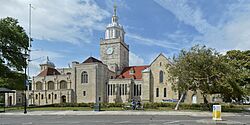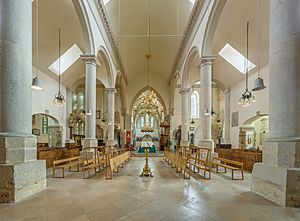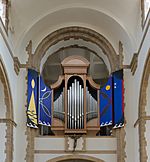Portsmouth Cathedral facts for kids
Quick facts for kids Portsmouth Cathedral |
|
|---|---|
| Cathedral Church of St Thomas of Canterbury | |
 |
|
| 50°47′26″N 1°06′15″W / 50.7905°N 1.1043°W | |
| Location | Portsmouth, Hampshire |
| Country | England |
| Denomination | Church of England |
| Previous denomination | Roman Catholic |
| Website | portsmouthcathedral.org.uk |
| History | |
| Status | Cathedral |
| Founded | 1180 |
| Dedication | St Thomas of Canterbury |
| Dedicated | 1188 |
| Architecture | |
| Functional status | Active |
| Style | Romanesque (Germanic) |
| Years built |
|
| Specifications | |
| Number of towers | 3 |
| Tower height | 121 feet (37 m) (tallest tower) |
| Bells | 12 |
| Administration | |
| Diocese | Portsmouth (since 1927) |
| Province | Canterbury |
The Cathedral Church of St Thomas of Canterbury, usually called Portsmouth Cathedral, is a special Anglican church. It is located in the middle of Old Portsmouth, England. Since 1935, this historic church has been the main cathedral for the Diocese of Portsmouth. It is also where the Bishop of Portsmouth has his official seat.
Portsmouth has two cathedrals. This one is Anglican, and the other is the Roman Catholic Cathedral of St John the Evangelist, Portsmouth. That church is about one mile to the north.
Contents
History of Portsmouth Cathedral
Building the First Church
Around the year 1180, a rich merchant named Jean de Gisors gave some land in Portsmouth. He gave it to a group of monks called the Augustinian canons from Southwick Priory. They used the land to build a chapel. This chapel was dedicated to St Thomas of Canterbury. He was an Archbishop who had been killed ten years earlier. This chapel later became a parish church in the 1300s. Then, in the 1900s, it became a cathedral.
The original church was finished in 1188. It was shaped like a cross, with a tower in the middle. This tower was used to look out and as a lighthouse. Only the main part (chancel) and the side sections (transepts) of the first building are still standing today.
Challenges and Rebuilding
The church survived a French attack in 1337. This attack destroyed most of Portsmouth during the Hundred Years War. However, in 1449, a bishop named Adam Moleyns was murdered by local sailors. Because of this, the town's people were excommunicated, and the church was closed. The church reopened in 1508 after the excommunication was lifted. In 1591, Elizabeth I even visited and worshipped in St Thomas's Church.
During the English Civil War in 1642, soldiers used the church tower to watch enemy movements. Parliamentary forces fired cannons at the tower, damaging the church. This ruined the medieval tower and the main hall (nave). After the king returned in 1660, Charles II allowed money to be collected to rebuild the tower and nave. This work happened from 1683 to 1693. The new nave was built in a classical style.
More seating areas (galleries) were added in 1708 and 1750 as more people came to church. A wooden dome with a lantern for ships was put on top of the tower in 1703. At the same time, eight bells were added. Two more bells were made in 1957. Today, the central tower has 12 bells in total. All the bells were made at Taylor's Bell Foundry.
Becoming a Cathedral
In 1927, the Diocese of Portsmouth was created. This meant big changes for the church. On May 1, 1927, the parish church of St Thomas of Canterbury became the main church for the new diocese. It was the second cathedral in Portsmouth. The Roman Catholic Cathedral of St John the Evangelist had already opened in 1882.
In 1932, architect Charles Nicholson was asked to make plans to expand the church. He wanted to make it big enough for its new role as a cathedral. By 1935, it was officially called a cathedral.
Nicholson chose a Neo-Byzantine style for the new parts. This style matched the classical look of the older choir area. By 1939, parts like the outer choir aisles, the tower, the transepts, and three sections of the nave were finished. The base of the 1600s tower was opened up. However, when World War II started in 1940, work on the expansion stopped. A "temporary" brick wall was put up to block off the unfinished parts. This wall stayed there for over fifty years. The Cathedral had minor damage during the war.
Nicholson passed away in 1949. Attempts to finish the building in the 1960s did not work because there wasn't enough money. By the mid-1980s, the "temporary" brick wall became unsafe. This made finishing the work urgent. The goal was to complete Nicholson's design, but with a shorter nave than originally planned. This shorter design fit the diocese's needs better.
Money was raised, and work began in January 1990. A fourth section of the nave was added, along with western towers, tower rooms, a rose window, a gallery, and a new stone font. In November 1991, the completed building was officially opened. Queen Elizabeth The Queen Mother was there for the ceremony.
Architecture and Design
The main entrance to the cathedral is through the bronze west doors. These doors were designed by Bryan Kneale. Their design is based on the tree of life, an old symbol of new life. The finished nave is a square area surrounded by a low, vaulted walkway. The furniture in the nave can be moved. This means the space can be used for concerts and exhibitions, as well as church services.
Above the main hall, on the rood screen, is a sculpture called Christus by Peter Eugene Ball. The case for the nave organ was designed by Didier Grassin in 2001. The inside panels were designed by Patrick Caulfield. The left panel shows night, with a lighthouse shining on the sea. This refers to Portsmouth's motto, "Heaven's Light Our Guide." The right panel shows day, with the sun and a fishing boat.
The tower has an opening for an organ loft. The font, made in 1991, is placed between the nave and the quire. In the south tower transept, there is a bronze statue of St John the Baptist by David Wynne. It was made in 1951 to remember a student who died on the Matterhorn mountain. On the north wall of this transept is a painting called The Miraculous Draught of Fishes by William Lionel Wyllie.
The north tower transept has a ceramic picture of the Virgin and Child. This was made by the Florentine artist Andrea della Robbia. The main altar stands on a platform made of Purbeck stone. It has mosaic work by Richard Noviss. The lectern, where readings are given, was a gift from Edward VII in 1903. The pulpit was put in place in 1693. The organ case, built by Francis Bird, has carved figures of cherubs and King David playing his harp. It is from 1718. In the south chancel aisle, there is a large memorial from 1631. It remembers George Villiers, 1st Duke of Buckingham, who was killed nearby.
In 1939, granite from Pulau Ubin, Singapore, was used for an extension of Portsmouth Cathedral.
Music at the Cathedral
Cathedral Choirs
There are three choirs at Portsmouth Cathedral. The Cathedral Choir has up to 20 boys and adult male singers. These adults include six choral scholars and six layclerks. They sing Choral Evensong on Mondays (men only), Tuesdays, Fridays, and Sundays (with the boys).
Cantate is the girls' choir. It started in 2006 and sings Choral Evensong every Thursday. The Cathedral Consort is a mixed choir of adults and younger singers. They sing Choral Evensong on Saturdays and when the other choirs are not in session. Sometimes, all the choirs sing together as the Great Choir for big services.
The choirs often travel. They have visited places like Tallinn (Estonia), Stockholm (Sweden), Salzburg (Austria), Berlin (Germany), Gozo (Malta), Ypres (Belgium), and Notre Dame des Neiges in France.
The Organist and Master of the Choristers, currently David Price, leads the Music Department. He is helped by the sub-organist and the Michael James Organ Scholar. Sachin Gunga has been the sub-organist since January 2018. The Michael James Organ Scholar is chosen each year. It is usually a university student taking a gap year.
Cathedral Organs
The cathedral has a large organ with three keyboards and 49 stops. It was installed in 1994 by Nicholson & Co Ltd. Its pipes came from an older organ built in 1861 for Manchester Cathedral. In 2001, the West Great Organ was added. This organ helps provide music directly into the nave, which is a separate space. The updated organ was officially opened in November 2001. A famous organist, Olivier Latry, played a concert. In 2017, a special horizontal Trompete de Maris ("Trumpet of the Sea") fanfare section was added above the main entrance.
In 2007, the cathedral also got a smaller chamber organ. It has one keyboard and three stops. It was built by Kenneth Tickell & Co.
Cathedral Leadership
As of late 2020, the main leaders of the cathedral include:
- The Dean – Anthony Cane (since March 2019)
- The Canon Chancellor and Vice Dean – Harriet Neale-Stevens (since September 2023)
- The Canon Precentor – Jo Spreadbury (since September 2015)
- The Diocesan Director of Social Enterprise and Engagement (Diocesan Canon) – Nick Ralph (since 2009)
See also







